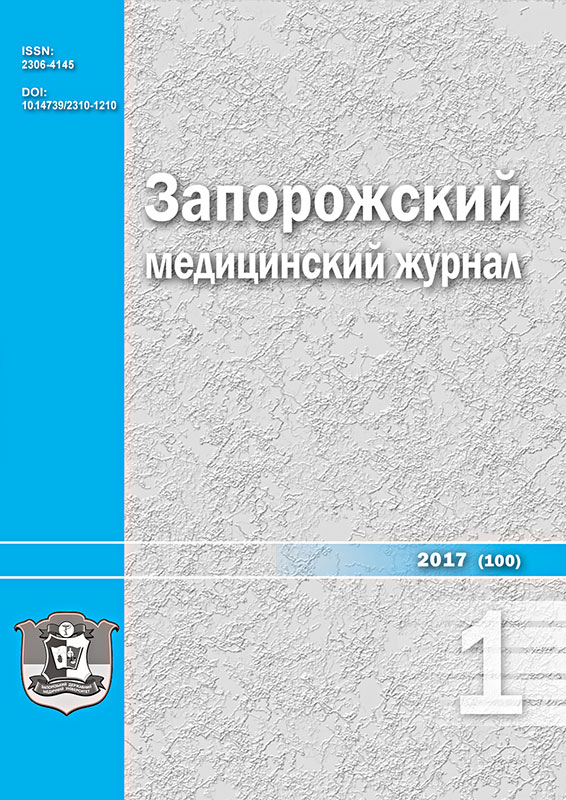The effect of combined treatment with transcranial direct current stimulation on cerebral blood flow in patients with cerebral palsy
DOI:
https://doi.org/10.14739/2310-1210.2017.1.91720Keywords:
transcranial direct current stimulation, cerebral palsy, doppler transcranial ultrasonographyAbstract
There is a close link between the activity of the brain and cerebral blood supply. Transcranial direct current stimulation (tDCS) modulates the activity of the cerebral cortex and thus affects the cerebral blood flow.
The aim of the study was to investigate the effect of combined treatment with tDCS on cerebral blood flow in patients with cerebral palsy (CP).
Materials and Methods. 60 patients with various forms of cerebral palsy were examined and received the course of treatment. The comparison group was formed from 30 children who received the course of basic medical and rehabilitation procedures. The main group included 30 children who, in addition to the same therapy, received a course of tDCS. A transcranial Doppler ultrasound examination of head blood vessels was used for the study of cerebral hemodynamics in children with cerebral palsy before and after combined treatment with tDCS.
Results. tDCS reduced asymmetry coefficient of blood flow velocity in the middle cerebral arteries (MCA) by 12.3 %, whereas in the comparison group only by 2.5 %; in the anterior cerebral artery (ACA) – 9.5 %, while in the comparison group – 0.8 %. tDCS significantly reduced the high mean blood flow velocity per cycle (MFV) in the basilar artery (BA), MCA and ACA (21.7 %, 18.3 % and 7.8 %, respectively); in the comparison group no statistically significant positive dynamics was observed. tDCS significantly increased the low MVF in the BA, MCA and ACA (29.7 %, 21.2 % and 9.7 % respectively); a statistically significant increase of MVF by 9.9 % was only in the CMA in the comparison group of patients.
Conclusions. Our data indicate that the use of tDCS in the combined treatment of CP patients improves cerebral hemodynamics in 87 % of patients, in contrast to 52 % in the comparison group. The addition of transcranial direct current stimulation method to the complex treatment of patients with cerebral palsy improves the effectiveness of treatment and may also positively influence on the disease clinical course.
References
Takai, H., Tsubaki, A., Sugawara, K., Miyaguchi, S., Oyanagi, K., Matsumoto, T., et al. (2016). Effect of transcranial direct current stimulation over the primary motor cortex on cerebral blood flow: a time course study using near-infrared spectroscopy. Advances in Experimental Medicine and Biology, 876, 335341. doi: 10.1007/978-1-4939-3023-4_42.
Hawkins, B. T., & Davis, T. P. (2005). The blood-brain barrier/neurovascular unit in health and disease. Pharmacological Reviews, 57(2), 173–185. doi: 10.1124/pr.57.2.4.
Mishra, A. J. (2016). Binaural blood flow control by astrocytes: listening to synapses and the vasculature. Physiology, (Sep 13). doi: 10.1113/JP270979.
Nitsche, M. A., Cohen, L. G., Wassermann, E. M., Priori, A., Lang, N., Antal, A., et al. (2008). Transcranial direct current stimulation: State of the art 2008. Brain Stimulation, 1(3), 206–223. doi: 10.1016/j.brs.2008.06.004.
Attwell, D., Buchan, A. M., Charpak, S., Lauritzen, M., Macvicar, B. A., & Newman, E. A. (2010). Glial and neuronal control of brain blood flow. Nature, 468, 232–43. doi:10.1038/nature09613.
Han, C. H., Song, H., Kang, Y. G., Kim, B. M., & Im, C. H. (2014). Hemodynamic responses in rat brain during transcranial direct current stimulation: a functional near-infrared spectroscopy study. Biomedical Optics Express, 13, 1812–1821. doi: 10.1364/BOE.5.001812.
Zheng, X., Alsop, D. C., & Schlaug, G. (2011). Effects of transcranial direct current stimulation (tDCS) on human regional cerebral blood flow. Neuroimage, 58, 26–33. doi: 10.1016/j.neuroimage.2011.06.018.
Gillick, B., Menk, J., Mueller, B., Meekins, G., Krach, L. E, Feyma, T., & Rudser, K. (2015). Synergistic effect of combined transcranial direct current stimulation/constraint-induced movement therapy in children and young adults with hemiparesis: study protocol. BMC Pediatrics, 15, 178. doi: 10.1186/s12887-015-0498-1.
Moliadze, V., Andreas, S., Lyzhko, E., Schmanke, T., Gurashvili, T., Freitag, C. M., & Siniatchkin, M. (2015). Ten minutes of 1 mA transcranial direct current stimulation was well tolerated by children and adolescents: Self-reports and resting state EEG analysis. Brain Research Bulletin, 119(Pt A), 25–33. doi: 10.1016/j.brainresbull.2015.09.011.
Semenova, К. А. (1973) Metodicheskie rekomendacii po primeneniyu rabochej klassifikacii detskogo cerebral´nogo paralicha [Guidelines for application of working classification of cerebral palsy]. Мoscow. [in Russian].
Downloads
How to Cite
Issue
Section
License
Authors who publish with this journal agree to the following terms:
Authors retain copyright and grant the journal right of first publication with the work simultaneously licensed under a Creative Commons Attribution License that allows others to share the work with an acknowledgement of the work's authorship and initial publication in this journal. 

